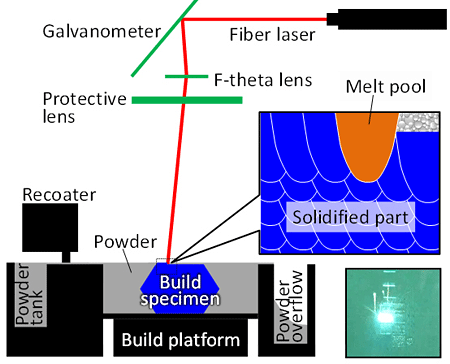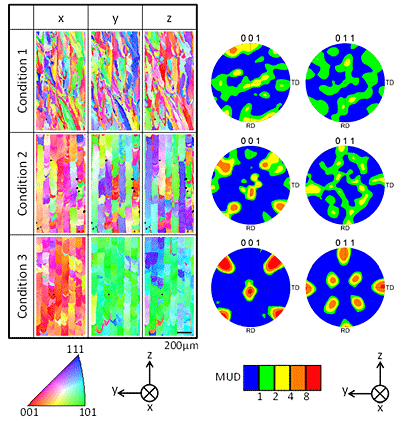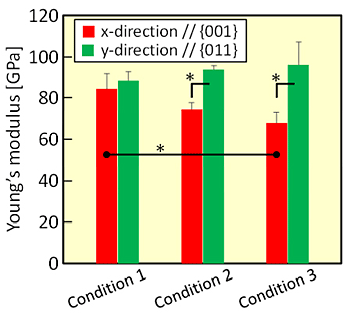Selective laser melting (SLM) (Fig. 1), a kind of powder bed fusion type additive manufacturing (AM), is recognized as a technology that enables to fabricate highly complicated 3-dimensional structures from powdered metallic materials. Recent investigations, however, demonstrated the ability of SLM to form crystallographically texturized parts. Highly texturized materials exhibit anisotropic functions; therefore, control of texture via AM is becoming attractive strategy for developing functionalized materials. In the present study, we tried to control the crystallographic texture in Ti-15Mo-5Zr-3Al (in mass%) alloy from randomly to highly-oriented textures via controlling laser conditions in SLM.
Ti-15Mo-5Zr-3Al that shows beta-phase (bcc) with lower Young’s modulus (approx. 85 GPa) than Ti-6Al-4V (approx. 110 GPa), the most widely used metallic alloy in biomedical field, therefore, it has become one of the most attractive biomedical implant material that is expected to suppress stress shielding and prevent degradation of bone functions. Recent investigations revealed the crystallographic orientation dependence of Young’s modulus in this alloy. The lowest (44.4 GPa) and the highest value (![]() 120 GPa) are shown along <001> and <111>, respectively, in a single crystalline form [S.H. Lee et al.: J. Mech. Behav. Biomed. Mater. 14 (2012) 48-54]. The lowest value is close to that of human cortical bones. However, a challenge for the practical application of the single crystalline implant is the creation of large single crystalline ingot which is not achieved through conventional methods. Thus we are focusing on AM as a technology for creating parts with crystallographic texture.
120 GPa) are shown along <001> and <111>, respectively, in a single crystalline form [S.H. Lee et al.: J. Mech. Behav. Biomed. Mater. 14 (2012) 48-54]. The lowest value is close to that of human cortical bones. However, a challenge for the practical application of the single crystalline implant is the creation of large single crystalline ingot which is not achieved through conventional methods. Thus we are focusing on AM as a technology for creating parts with crystallographic texture.
Gas atomized alloy powder was prepared for fabrication. The specimens with dimensions of 5 mm × 5 mm × 10 mm were produced utilizing an SLM apparatus (EOS M290). A bidirectional laser scan without rotation between the layers (Scan Strategy_X) was performed. In order to find optimal conditions for texture evolution, a laser power (P) and scan speed (v) were varied, while other parameters (scan pitch (d), layer thickness (t), etc.) were set constant. Of these, three conditions (Table 1) are reported here. Inverse pole figure (IPF) maps representing crystallographic orientations along x-, y-, and z-axes, and the corresponding {001} and {011} pole figures (PF) acquired on the y-z plane (perpendicular to the scanning direction x) of the manufactured specimens under each condition are shown in Fig. 2. In the case where the laser power and scan speed were small, anisotropy was hardly observed in the crystal orientation, but as the laser output and scanning speed became larger, the crystallographic orientation became remarkable. Under condition 3, a single crystalline-like texture in which <001> was strongly oriented in the scanning (x) direction and <011> was oriented in the y and the building (z) direction was evolved. Furthermore, according to the IPF map, crystal grains elongated in the building (z) direction are observed under any conditions, and the grain size is larger than 0.06 mm of the layer thickness. From this, it is clear that epitaxial growth has occurred. However, the stability of the epitaxial growth is obviously higher in condition 3 than in condition 1 and crystal orientation is feasible to be maintained.
Figure 3 shows the Young’s modulus in the <001>-oriented x-direction and the <011>-oriented y-direction. The specimen fabricated under condition 1 with isotropic texture showed similar modulus in any direction, in contrast in conditions 2 and 3 in which the texture was evolved, <001>-oriented x-direction showed significantly lower Young’s moduli compared to the <011>-oriented y-direction. The anisotropy of Young’s modulus became the largest under the condition 3 with the most prominent crystallographic texture.
However, the Young’s modulus obtained in this research is higher than the ideal value (44.4 GPa // <001>, 85 GPa // <011>) in the single crystalline. As a factor thereof, it can be mentioned that Al which is a light element is evaporated when it is melted during gas atomizing and SLM process [T. Ishimoto et al.: Scripta Mater. 132 (2017) 34-38]. Al is a destabilizing element of the β phase, and it is considered that the decrease of the β phase instability due to the reduction of the Al concentration results in the increase of Young's modulus [M. Tane et al.: Acta Mater. 59 (2011) 6975-6988]. Furthermore, in order to expand the selectivity of Young’s modulus, it can be said that the further enhancement of crystallographic texture is essential.



